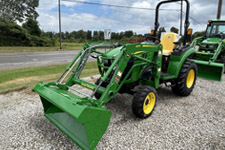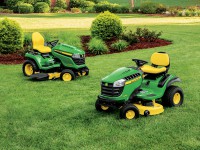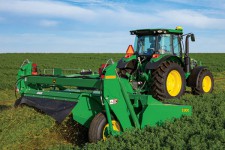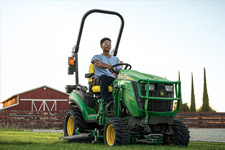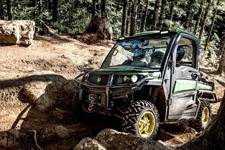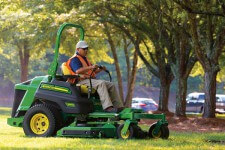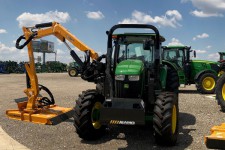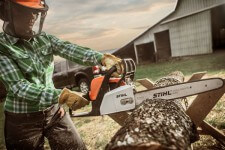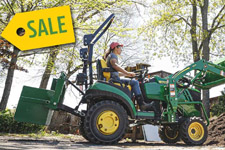- On Sale
- Build Your Own
- Used Equipment
- New Equipment
- Trade In
- Parts
- Service
- Aged Equipment Clearance
- Buy Online
- Precision Farming
-
- The Basics Of Haymaking
- Round Baler Basics for a 460M Round Baler
- How to Load Net Wrap on a 460M Round Baler
- Top 10 Implements For Livestock Operations
- How to store large round bales
- How to set up and operate a mower conditioner
- How to use a mechanical grapple
- Pick up grass clippings using a drive-over mower deck
John Deere AutoPath™ Guidance Planner

AutoPath™
Guidance Planner
- Automatically create precise guidance plans for the entire crop season based on exact crop location or a field boundary
- Achieve the perfect first pass every time with AutoPath (boundaries)
- Eliminate one or more passes through your field to work more efficiently
- Precisely seed between the rows of last year's crop, plant directly on a fertilizer strip, spray standing crops without driving over them, consistently harvest at capacity and say goodbye to that row of shame
- Get a Quote Build Your Own PowerGard Extended Warranty Evaluate My Trade
- Find My Location
- Payment Calculator
-
Share
Get A Quote
Fields with asterisks* are required. Please email our helpful staff with any questions or comments using the contact form.
Loan Calculator
Use the Loan Calculator to help you determine the financing and payment options that are best for you.
**The accuracy of this calculator and its applicability to your circumstances is not guaranteed. You should obtain personal advice from qualified professionals. This information is provided for illustrative purposes only and does not constitute an application. This notice does not guarantee loan approval, nor is it an offer or commitment to make a loan to you on the above terms.
Features
Have confidence from start to finish
From the Farmers:
"I would never go back to not having AutoPath™…one of the best things on the farm."
“AutoPath is next level. It’s like ordering a tractor without an air-conditioned cab…You wouldn’t.”
AutoPath™ transforms precision into simplicity. No matter the operation—tilling, prepping, planting, spraying, or harvesting—AutoPath supports accurate execution of farming practices that might otherwise be difficult or impossible. It automatically creates guidance lines throughout the entire field that guide you to exactly where you need to be, across every field, every season, improving in-field performance and productivity no matter who’s in the driver’s seat.
With AutoPath, you can:
- Seed precisely between last year’s crop rows
- Plant directly on fertilizer strips
- Spray without damaging crops
- Harvest efficiently and consistently at full capacity
AutoPath removes the guesswork by automatically adjusting guidance lines throughout the year, making your job easier and more effective, even in challenging field conditions.
There are two ways to automatically generate a full field of guidance lines:
- AutoPath (Rows)– based on crop row data
- AutoPath (Boundaries)– based on field boundary data
Explore the differences and similarities below to find the best fit for your operation. You might just find that both methods are your keys to success.
(Rows)
|
(Rows) & (Boundaries) |
(Boundaries)
|
LINE GENERATION |
||
Generates guidance lines using documented row data from a preliminary pass through the field, like planting or seeding. This is known as the “source operation.” |
|
Generates guidance lines using recorded field boundary information. Field boundaries must be driven and recorded with SF3 or higher correction signal. |
The location of the documented source operation serves as the reference point for future passes, like spraying and harvesting, ensuring accurate guidance throughout the entire season. |
|
Guidance lines |
USAGE REQUIREMENTS |
||
|
|
|
USE CASES |
||
Row crop operations, like but not limited to:
|
See this story for ways these AutoPath modes work together throughout a growing season. |
Operations that do not require machines to precisely follow exact rows throughout each job, like but not limited to:
|
BENEFITS |
||
|
Makes field work easy by generating guidance lines for the field and headland area and adjusting the location of the lines for varying machine and implement widths based on the job at hand. |
|
|
Complete field work with sub-inch accuracy |
|
Automatically generate full-field guidance plans from crop row data
"I absolutely love it. After the planter goes through, we have no issues side dressing, spraying, and harvesting."
How it works:
AutoPath™ creates guidance tracks for the entire field using crop row data recorded during the first pass through the field, whether that be a fertilizer application, tillage, or planting pass. The exact crop row or fertilizer location is captured and mapped using an implement mounted, StarFire™ Receiver, which means that fundamentally, farmers don’t need to do anything different as they work a field. In fact, adding this technology makes their lives easier as time passes.
AutoPath lets users begin each 'next pass' through the field quickly and confidently using their previously recorded data to guide them.
 Exact crop location is recorded using an implement-mounted receiver during the first pass of the crop year
Exact crop location is recorded using an implement-mounted receiver during the first pass of the crop year
 Use AutoPath to complete later passes in standing crop with confidence
Use AutoPath to complete later passes in standing crop with confidence
Find equipment requirements and compatibility for crop row documentation here.
The AutoPath™ (Rows) advantage
Farmers have been using AutoPath (Rows) since 2020. Those who have adopted it, have been able to see the advantage that it provides their operation.
"If you have odd-shaped fields like we do, it makes headland line management a piece of cake. Also, if you have to swing out for a pole or a standpipe, it records that position in the primary pass even while free handing and the planter steers it."
"It’s great to start planting at night. Use the lines from the previous year and go."
Check out some of the additional advantages AutoPath (Rows) can provide its users.
- Automatically generates field guidance tracks for the next pass, accommodating for equipment width, based on actual planted crop rows.
- Accomplish work you could not manually. - Stay precisely on top preplant fertilizer strips when planting. Stay off emerged crops when spraying, without having to slow down in fear of damaging crops. Don’t count guess rows when you’re harvesting crops. Oh, and don’t use your hands to steer the machine while you’re at it.
- Reduces hunting for guess rows when spraying or harvesting a field.
- Makes harvesting easier in down crop conditions, and less than ideal conditions in general.
- Farmers can now easily use implements and machines of varying widths. Plant with a 24-row planter and harvest with a 16-row corn head with no issues. AutoPath keeps you on established guidance tracks that accommodate each machine, reducing the risk of partial width passes.
- Eliminates the complexity of trying to manage guidance tracks, especially in standing crops, from tillage to harvest.
- Helps maximize overall yield by reducing crop damage. When spraying at high speeds, even a few short seconds of driving over crop can cause measurable yield losses. Take harvest into consideration. In higher yielding corn, every second of driving on the row can lead to 17.6 L (0.5 bu) or more in loss. Over the course of a day, the amount of damaged crop can add up fast, impacting your bottom line.
- Row crops are rarely simple, straight lines, and fields often have irregular boundaries. Planting around water holes, waterways, or terraces adds complexity, but these challenges can be easily overcome with the AutoPath, path planning tool.
Automatically generate full-field guidance plans from driven boundaries
"AutoPath™ (boundaries) has been a really great feature for us. I just got a new sprayer and didn’t really have to adjust anything because we had an accurate boundary that just drives the sprayer around the field for me. I didn’t have to worry about where I was driving or if I was going to hit something with the longer booms, I could focus more on learning the machine functions and doing a good job applicating."
There is no need for an implement receiver or source operation, it all starts with a driven boundary. (Click here to learn the ins and outs of proper field boundary creation) Automatically generating a guidance plan for the entire field using AutoPath (boundaries) is as easy as 1, 2, 3.
- Drive and record the boundary of the field using a StarFire™ receiver with SF3 or greater correction signal. – See a pro boundary-creator at work.
- Set the headland size (implement/machine track spacing) and offset type (Constant or Top/Bottom).
- AutoPath automatically generates in-field guidance tracks, separate from the headland tracks, using one of three methods: Heading angle, align to boundary, from existing track. Learn more about each of these track generation methods here.
 Use a simple heading angle, align to boundary, or an existing track to build in-field guidance lines
Use a simple heading angle, align to boundary, or an existing track to build in-field guidance lines
You may be asking yourself, "how does this solution differ from Boundary Fill?" There are several distinct differentiators between the two, one of which, was previously alluded to; AutoPath (boundaries) creates a guidance plan for the entire field, generating field and headland guidance tracks separately. (For a more in-depth comparison of AutoPath (boundaries) and Boundary Fill).
Headland guidance tracks follow the shape of the field boundary, while the in-field guidance tracks are built automatically according to the generation method selected. This functionality allows farmers to work their fields more efficiently, as they can create plans that minimize the number of passes required to complete the field by simply adjusting the track generation inputs.
 Headland and in-field guidance tracks are created separate from one another
Headland and in-field guidance tracks are created separate from one another
If you have a larger field that you farm in multiple 'zones', AutoPath can create a single plan for each of the zones applying the same settings (heading angle, headland, etc.) to the entire field.
If needed, a user can update heading angles mid-field. See the Insider's Update for more information on how to accomplish this.
 Single field with multiple exterior boundary shapes with the same field settings
Single field with multiple exterior boundary shapes with the same field settings
Plan and start field work quickly
AutoPath™ (boundaries) creates a seamless, end-to-end experience for its users, making planning (and field work) quick and painless. Choose to setup and preview full-field guidance plans online using the John Deere Operations Center or create plans from the ground up from the seat of the cab when you arrive at the field.
This John Deere-exclusive path planning tool provides farmers the flexibility to adjust guidance plans that were created online directly within their G5 or Gen4 machine display – no need to go back into the Operations Center and adjust and perfect the plan.
Using three simple inputs (field boundary, headland, in-field track generation method) you can effortlessly create guidance plans for the entire crop season in one sitting. When the time is right, incorporate the appropriate AutoPath plan into setup file creator or Work Planner and get to work. It is really that simple.
| Operations Center |  |
G5 or Gen4 Machine Display |
 |
 |
|
| Setup, preview and save AutoPath full-field guidance plans | Execute Operations Center-generated AutoPath plan and adjust as needed or create an entirely new plan on the machine display |
And because AutoPath generates a single plan for the entire field, swapping and managing multiple guidance tracks as you work a field is a thing of the past.
Planning, starting, and executing field work has never been easier, and we will only continue to make improvements over time to enhance this user experience.
AutoPath™ (Boundaries) delivers the perfect first pass
"We are primarily using the Align to Boundary feature because we really love that we can have things perfect on one side of the field (no partial passes) and be able to use that same efficient plan throughout the entire year with all our equipment."
Be confident and stress-free, knowing that all operators have the right guidance tracks from start to finish. The Align to Boundary guidance track generation method provides the most efficient first pass through the field, resulting in no skips and minimal overlap. Using this method, AutoPath will default to the longest side of the field boundary you are planning work for and build from that side across the entire field using the track spacing input by the user.
Users can precisely adjust the boundary line being used to create the in-field guidance tracks. Unless farmers have perfectly square fields, which we know is uncommon, users will want to adjust the dots to achieve the most efficient guidance plan and for the most accurate performance when the machine is ready to execute the planned work. See 'PRO-TIP' below.

AutoPath creates guidance tracks for the entire field using crop row data recorded during the first pass through the field, whether that be a fertilizer application, tillage, or planting pass. The exact crop row or fertilizer location is captured and mapped using an implement mounted, StarFire™ Receiver, which means that fundamentally, farmers don’t need to do anything different as they work a field. In fact, adding this technology makes their lives easier as time passes.
AutoPath lets users begin each 'next pass' through the field quickly and confidently using their previously recorded data to guide them.
Check out some of the additional advantages AutoPath (rows) can provide its users.
- Automatically generates field guidance tracks for the next pass, accommodating for equipment width, based on actual planted crop rows.
- Accomplish work you could not manually. - Stay precisely on top preplant fertilizer strips when planting. Stay off emerged crops when spraying, without having to slow down in fear of damaging crops. Don’t count guess rows when you’re harvesting crops. Oh, and don’t use your hands to steer the machine while you’re at it.
- Reduces hunting for guess rows when spraying or harvesting a field.
- Makes harvesting easier in down crop conditions, and less than ideal conditions in general.
- Farmers can now easily use implements and machines of varying widths. Plant with a 24-row planter and harvest with a 16-row corn head with no issues. AutoPath keeps you on established guidance tracks that accommodate each machine, reducing the risk of partial width passes.
- Eliminates the complexity of trying to manage guidance tracks, especially in standing crops, from tillage to harvest.
- Helps maximize overall yield by reducing crop damage. When spraying at high speeds, even a few short seconds of driving over crop can cause measurable yield losses. Take harvest into consideration. In higher yielding corn, every second of driving on the row can lead to 17.6 L (0.5 bu) or more in loss. Over the course of a day, the amount of damaged crop can add up fast, impacting your bottom line.
- Row crops are rarely simple, straight lines, and fields often have irregular boundaries. Planting around water holes, waterways, or terraces adds complexity, but these challenges can be easily overcome with the AutoPath, path planning tool.
AutoPath™ (Boundaries) versus Boundary Fill
With the introduction of AutoPath (Boundaries), the million-dollar question is, "How is this solution any different from Boundary Fill?"
We are happy you asked. Let us answer that for you.
Attribute |
Boundary Fill |
AutoPath (Boundaries) |
Requires an accurate, driven field boundary |
X |
X |
Requires a headland boundary + offset type |
|
X |
Works with any correction signal level (will result in lower accuracy / repeatability using signals below SF3) |
X |
|
Requires SF3 or higher correction signal to utilize |
|
X |
Allows operators to steer precisely along the outside passes of the field |
X |
X |
Creates a single guidance track outside of the field area, allowing machine to operate outside of the field |
X |
|
All guidance tracks stay within the field’s boundary |
|
X |
Creates guidance tracks around the outside of the field that follow the field’s shape |
X |
X |
Continuously creates guidance tracks that follow the field shape as you work inward, away from the boundary |
X |
|
Requires at least one additional guidance track type |
X |
|
Creates a separate set of guidance tracks in the workable field area that do not follow the field’s shape |
|
X |
The number of passes around the outside of the field can be predetermined using track spacing + headland size |
|
X |
In-field guidance tracks can be adjusted |
|
X |
Square corners, and other scenarios are created, in which the machine cannot stay on the guidance tracks |
X |
|
Guidance tracks can be extended for easier tracking throughout the field, especially on corners |
X |
X |
Guidance can be created within the machine display |
X |
X |
Guidance can be created within the Operations Center |
|
X |
For you visual learners, below you will find the outcome of each guidance tool within the same field.
Things to note:
- Some guidance tracks fall outside of the field boundary, allowing the machine to operate outside of the designated field area
- A single guidance track is created for each pass around the field
- The guidance tracks around the corners of the field are squared off
- Guidance tracks will continue to populate following the field boundary as the machine works inward from the field boundary
- This plan was created directly within the machine’s display
 Guidance created using Boundary Fill
Guidance created using Boundary Fill
Things to note:
- All guidance tracks appear inside of the field boundary, which prevents the machine from operating outside of the designated field area
- Multiple guidance tracks are created for each pass around the field
- The guidance tracks around the corners of the field have extensions to make tracking them with the machine simpler
- The outer guidance tracks follow the exact field shape within the headland area, and in-field tracks are planned using one of three methods:
- Align to boundary
- Heading angle
- From an existing track
- This guidance plan can be created directly within the machine’s display or within the Operations Center
 Guidance created using AutoPath (Boundaries)
Guidance created using AutoPath (Boundaries)
Now that you understand some of the key differences between the two boundary-based guidance options provided by John Deere, you can select the tool that is right for you.
If you are interested in trying AutoPath (boundaries) for the first time, or if you simply need a refresher, check out the step-by-step training materials within the Equipment Mobile App to get started creating full-field guidance plans today.
AutoPath™ (Boundaries) + (Rows) work together seamlessly throughout the crop year
Regardless of whether you produce row-crops, like corn, or you are growing soybean or small grains, AutoPath is the guidance solution for you. This technology enables precise execution of farming practices that might not be possible otherwise.
- Seed between the rows of previously drilled small grains (boundaries)
- Run minimum-till or no-till implements precisely between last year’s crop rows (boundaries + rows)
- Plant cover crops to optimize emergence and crop emergence (boundaries + rows)
- Plant crops precisely on top of fertilizer strips to maximize yields (rows)
AutoPath (Boundaries) and AutoPath (Rows) features work independently, or seamlessly together to provide optimal path planning throughout the entire crop season.
The graphic below illustrates how a grower can maximize the benefits of AutoPath by using both (Rows) and (Boundaries) modes in tandem throughout the crop season. By integrating these two modes, growers can streamline operations, reduce inefficiencies, and ultimately improve yields.

In this example, the grower begins the season with a pre-plant strip-till pass. Since there are no rows documented yet, this grower can use their driven field boundary data to generate an AutoPath plan using (Boundaries) mode. By selecting the Align to Boundary method, they ensure a clean, and perfect first pass—minimizing skips, overlaps, and unnecessary partial passes. Growers can expect to eliminate at least one pass through the field using this method.
As the grower executes this strip-till plan that was generated using AutoPath (Boundaries), precise row data can be documented and used for future AutoPath plans using ‘rows’ mode.
When it’s time to plant, the grower can use that same row data to precisely guide the planter—placing seeds directly on or just offset from the strip-till rows for optimal emergence. During planting, the farmer can choose to document new row data, which can then be used to guide spraying operations. AutoPath (rows) plan will place guidance lines throughout the field, that keeps sprayer tires stay off the crop rows, protecting young plants and preserving yield potential.
When harvest arrives, the same row data captured during the planting step, can be used to guide the combine. This eliminates the need to manually count rows and helps avoid the dreaded “row of shame” left behind from misalignment.
Finally, after harvest, the farmer can return to Boundaries mode to create a tillage plan—setting a specific angle for the tillage pass to prepare the field for the next season.
While each AutoPath mode is powerful on its own, using Rows and Boundaries together throughout the season creates a seamless, data-driven workflow that enhances efficiency and productivity from start to finish.
Here are some additional ways you can use AutoPath (boundaries + rows) to maximize your operation throughout the entire crop year.
Small Grains: AutoPath (Boundaries)-only

Soybeans: AutoPath (Boundaries) + (Rows)

Corn: AutoPath (Boundaries) + (Rows)

AutoPath (Rows)-only

As you can see, you’ve got options when creating guidance blueprints for each of your fields throughout the entire crop season. Whether you use AutoPath (boundaries), (rows), or both together, you are setting yourself up for success for the production year.
**Price on new John Deere Equipment only available within the LandPro Equipment selling area, pricing subject to change, see your LandPro Equipment Sales rep for details.
-
Avon, NY
(585) 226-9680 -
Batavia, NY
(585) 948-5261 -
Brockport, NY
(585) 637-3700 -
Centre Hall, PA
(814) 364-1421 -
Clarence Center, NY
(716) 741-9115 -
Clymer, NY
(716) 355-4236 -
East Palestine, OH
(330) 426-2166 -
Edinboro, PA
(814) 734-1552 -
Fairmount City, PA
(814) 764-5159 -
Falconer, NY
(716) 665-3110 -
Halifax, PA
(717) 362-3132 -
Hall, NY
(585) 526-6325 -
Macedon, NY
(585) 425-4428 -
Mifflintown, PA
(717) 436-5553 -
Savannah, NY
(315) 594-0115 -
Springville, NY
(716) 592-4058 -
Stoneboro, PA
(724) 376-3740 -
Watsontown, PA
(570) 538-3557 -
Silver Springs, NY
(585) 591-1670
**Price on new John Deere Equipment only available within the LandPro Equipment selling area, pricing subject to change, see your LandPro Equipment Sales rep for details.
New Products
Used Equipment
© LandPro Equipment 2025 | All Rights Reserved.
Site by EquipmentLocator.com

